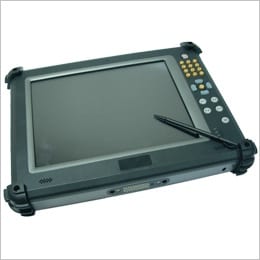This article was reprinted with permission from Field Technologies Online. For the full-length version, click here (subscription required).
Unless you’ve been hiding under a rock for the past year, I’m sure you’re cognizant of the overwhelming buzz surrounding tablet computers. Amidst that buzz is the debate of whether a consumer-grade tablet (iPad, anyone?) can serve as an effective tool in field operations. The answer I hear most often to that question? A resounding “NO!” When Labatt Food Service decided to go tablet, the company knew its device of choice would need to be rugged — and chose a device that has provided significant value to its operations.
 Labatt Food Service is a privately owned, $1 billion food service distribution company that services more than 6,000 customers from five warehouse locations across Texas and New Mexico. The company employs 400 drivers that rotate driving 250 trucks. Most drivers are delivery drivers who deliver products to approximately ten to twelve customer locations per shift. Labatt also employs line drivers, who deliver product from the warehouse to a Labatt depot location. Warehouse employees work during the day and evening to unload incoming products, prepare shipments, and load orders onto delivery trucks. Delivery drivers arrive to begin delivery shifts as early as three o’clock in the morning.
Labatt Food Service is a privately owned, $1 billion food service distribution company that services more than 6,000 customers from five warehouse locations across Texas and New Mexico. The company employs 400 drivers that rotate driving 250 trucks. Most drivers are delivery drivers who deliver products to approximately ten to twelve customer locations per shift. Labatt also employs line drivers, who deliver product from the warehouse to a Labatt depot location. Warehouse employees work during the day and evening to unload incoming products, prepare shipments, and load orders onto delivery trucks. Delivery drivers arrive to begin delivery shifts as early as three o’clock in the morning.
Paper-Based Process Labor-Intensive, Compounded By DOT Regulations.
Until Labatt’s recent tablet deployment, the company used a paper-based method to track all delivery departures, arrivals, and returns, as well as the hours of service logging the drivers are required to do by the DOT (Department of Transportation). When drivers arrived in the morning for their delivery shift, they received a paper report that listed information about each of their delivery stops (address, inventory to be delivered, etc.) as well as paper invoices for each customer. At each delivery stop, drivers had to take manual notes of a successful delivery (time they arrived, what was delivered, how long they were onsite) or any damaged, missing, or returned merchandise (any discrepancy with the invoice uncovered onsite).
“This process was a very laborious and redundant one,” notes Blair Labatt III, project lead at Labatt Food Service. “And, as with any manual process, it was error-prone. Sometimes the necessary notes weren’t taken at all; oftentimes the notes weren’t taken accurately. A driver would forget to write notes while on-site only to fill them in later with erroneous data. The accuracy of the manual notes was in question much of the time.”
 Not to mention, with the manual process Labatt had in place, the company had zero visibility into the drivers’ activities once they left for the day. While the report the driver received in the morning included suggested routes, drivers were ultimately responsible for routing themselves, and Labatt had no way to validate drivers used the most efficient routes possible. Further, without visibility into driver location, Labatt was unable to provide anything more detailed than an estimated time of arrival to their customers. For instance, if a customer called their sales rep or customer service because their delivery was late, the only way labatt could investigate was to call the driver’s cell phone. Since drivers aren’t allowed to answer their phones while driving, they had to pull over to return the call — wasting time and delaying a response to the customer.
Not to mention, with the manual process Labatt had in place, the company had zero visibility into the drivers’ activities once they left for the day. While the report the driver received in the morning included suggested routes, drivers were ultimately responsible for routing themselves, and Labatt had no way to validate drivers used the most efficient routes possible. Further, without visibility into driver location, Labatt was unable to provide anything more detailed than an estimated time of arrival to their customers. For instance, if a customer called their sales rep or customer service because their delivery was late, the only way labatt could investigate was to call the driver’s cell phone. Since drivers aren’t allowed to answer their phones while driving, they had to pull over to return the call — wasting time and delaying a response to the customer.
To read the rest of this article, head over to Field Technologies Online.


Share this: